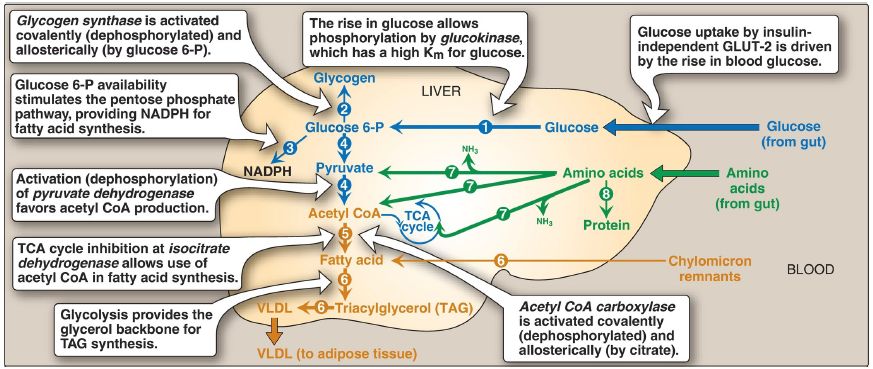
Liver : Fat metabolism
 المؤلف:
Denise R. Ferrier
المؤلف:
Denise R. Ferrier
 المصدر:
Lippincott Illustrated Reviews: Biochemistry
المصدر:
Lippincott Illustrated Reviews: Biochemistry
 الجزء والصفحة:
الجزء والصفحة:
 24-11-2021
24-11-2021
 1266
1266
Liver : Fat Metabolism
1. Increased fatty acid synthesis: Liver is the primary site of de novo synthesis of FA (Fig. 1, ). FA synthesis, a cytosolic process, is favored in the absorptive period by availability of the substrates acetyl CoA (from glucose and amino acid metabolism) and NADPH (from glucose metabolism in the pentose phosphate pathway) and by the
activation of ACC, both by dephosphorylation and by the presence of its allosteric activator, citrate. [Note: Inactivity of AMPK favors dephosphorylation.] ACC catalyzes the formation of malonyl CoA from acetyl CoA, the rate-limiting reaction for FA synthesis . [Note: Malonyl CoA inhibits carnitine palmitoyltransferase-I (CPT-I) of FA oxidation . Thus, citrate directly activates FA synthesis and indirectly inhibits FA degradation.]
a. Source of cytosolic acetyl coenzyme A: Pyruvate from aerobic glycolysis enters mitochondria and is decarboxylated by PDH. The acetyl CoA product is combined with oxaloacetate (OAA) to form citrate via citrate synthase of the TCA cycle. Citrate leaves the mitochondria (as a result of the inhibition of isocitrate dehydrogenase by ATP) and enters the cytosol. Citrate is cleaved by ATP citrate lyase (induced by insulin), producing the acetyl CoA substrate of ACC plus OAA.
b. Additional source of NADPH: The OAA is reduced to malate, which is oxidatively decarboxylated to pyruvate by malic enzyme as NADPH is formed .
2. Increased triacylglycerol synthesis: TAG synthesis is favored because fatty acyl CoA are available both from de novo synthesis and from hydrolysis of the TAG component of chylomicron remnants removed from the blood by hepatocytes . Glycerol 3-phosphate, the backbone for TAG synthesis, is provided by glycolysis . The liver packages these endogenous TAG into very-low-density lipoprotein (VLDL) particles that are secreted into the blood for use by extrahepatic tissues, particularly adipose and muscle tissues (see Fig. 1 ).

Figure 1: Major metabolic pathways in the liver in the absorptive state. [Note: The acetyl coenzyme A (CoA) is also used for cholesterol synthesis.] The numbers in circles, which appear both in the figure and in the text, indicate important pathways for carbohydrate, fat, or protein metabolism. Blue text = intermediates of carbohydrate metabolism; brown text = intermediates of lipid metabolism; green text = intermediates of protein metabolism; P = phosphate; TCA = tricarboxylic acid; VLDL = very-low-density lipoprotein; GLUT = glucose transporter; NADPH = nicotinamide adenine dinucleotide phosphate; NH3 = ammonia.
 الاكثر قراءة في الكيمياء الحيوية
الاكثر قراءة في الكيمياء الحيوية
 اخر الاخبار
اخر الاخبار
اخبار العتبة العباسية المقدسة


